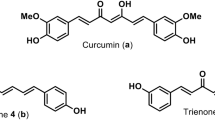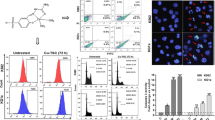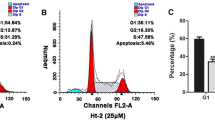Abstract
The anti-cancer activities of curcumin (CUR), a polyphenol derived from the plant Curcuma longa, has been extensively studied. In the present study, we found that CUR displayed anti-multidrug-resistant (MDR) activity in K562/A02 cells. A short-time treatment with CUR sufficiently and equally induced DNA damage, decreased cell viability, and triggered apoptosis in parent K562 and MDR K562/A02 cells. The short-time treatment with CUR also caused decrease of pro-caspase 3 in both cell lines and decrease of pro-caspase 9, increase of PARP cleavage and the ratio of Bax/Bcl-xL in MDR K562/A02 cells. Further experiment revealed that CUR was capable of down-regulating P-glycoprotein in MDR K562/A02 cells. Moreover, we observed that Cu2+ enhanced CUR-mediated apoptosis which was blocked by antioxidants N-acetyl-cysteine and catalase. In summary, the short-time treatment with CUR sufficiently induced DNA damage, decreased cell viability and triggered apoptosis in MDR K562/A02 cells and Cu2+ enhanced CUR-mediated apoptosis which due to reactive oxygen species generation.




Similar content being viewed by others
Abbreviations
- CAT:
-
Catalase
- CUR:
-
Curcumin
- DOX:
-
Doxorubicin
- MDR:
-
Multidrug-resistant
- MTT:
-
Tetrazolium bromide
- NAC:
-
N-acetyl-cysteine
- RF:
-
Resistance factor
- ROS:
-
Reactive oxygen species
- VP16:
-
Etoposide
References
Perez-Tomas R (2006) Multidrug resistance: retrospect and prospects in anti-cancer drug treatment. Curr Med Chem 13:1859–1876
Gottesman MM, Ling V (2006) The molecular basis of multidrug resistance in cancer: the early years of P-glycoprotein research. FEBS Lett 580:998–1009
Hennessy M, Spiers JP (2007) A primer on the mechanics of P-glycoprotein the multidrug transporter. Pharmacol Res 55:1–15
Zhou SF (2008) Structure, function and regulation of P-glycoprotein and its clinical relevance in drug disposition. Xenobiotica 38:802–832
Joe B, Vijaykumar M, Lokesh BR (2004) Biological properties of curcumin-cellular and molecular mechanisms of action. Crit Rev Food Sci Nutr 44:97–111
Maheshwari RK, Singh AK, Gaddipati J, Srimal RC (2006) Multiple biological activities of curcumin: a short review. Life Sci 78:2081–2087
Aggarwal BB, Kumar A, Bharti AC (2003) Anticancer potential of curcumin: preclinical and clinical studies. Anticancer Res 23:363–398
Kunnumakkara AB, Anand P, Aggarwal BB (2008) Curcumin inhibits proliferation, invasion, angiogenesis and metastasis of different cancers through interaction with multiple cell signaling proteins. Cancer Lett 269:199–225
Das T, Sa G, Saha B, Das K (2010) Multifocal signal modulation therapy of cancer: ancient weapon, modern targets. Mol Cell Biochem 336:85–95
Basile V, Ferrari E, Lazzari S, Belluti S, Pignedoli F, Imbriano C (2009) Curcumin derivatives: molecular basis of their anti-cancer activity. Biochem Pharmacol 78:1305–1315
Hussain AR, Al-Rasheed M, Manogaran PS, Al-Hussein KA, Platanias LC, Al Kuraya K, Uddin S (2006) Curcumin induces apoptosis via inhibition of PI3′-kinase/AKT pathway in acute T cell leukemias. Apoptosis 11:245–254
Zheng S, Chen A (2004) Activation of PPAR gamma is required for curcumin to induce apoptosis and to inhibit the expression of extracellular matrix genes in hepatic stellate cells in vitro. Biochem J 384:149–157
Aggarwal BB, Shishodia S, Takada Y, Banerjee S, Newman RA, Bueso-Ramos CE, Price JE (2005) Curcumin suppresses the paclitaxel-induced nuclear factor-kappaB pathway in breast cancer cells and inhibits lung metastasis of human breast cancer in nude mice. Clin Cancer Res 11:7490–7498
Shishodia S, Amin HM, Lai R, Aggarwal BB (2005) Curcumin (diferuloylmethane) inhibits constitutive NF-kappaB activation, induces G1/S arrest, suppresses proliferation, and induces apoptosis in mantle cell lymphoma. Biochem Pharmacol 70:700–713
Luan FJ (1993) Establishment of the multidrug-resistant cell line K562/A02 and its drug-resistant properties. Zhonghua Zhong Liu Za Zhi 15:101–103
Yang CZ, Luan FJ, Xiong DS, Liu BR, Xu YF, Gu KS (1995) Multidrug resistance in leukemic cell line K562/A02 induced by doxorubicin. Zhongguo Yao Li Xue Bao 16:333–337
Cai YJ, Lu JJ, Zhu H, Xie H, Huang M, Lin LP, Zhang XW, Ding J (2008) Salvicine triggers DNA double-strand breaks and apoptosis by GSH-depletion-driven H2O2 generation and topoisomerase II inhibition. Free Radic Biol Med 45:627–635
Cao J, Jia L, Zhou HM, Liu Y, Zhong LF (2006) Mitochondrial and nuclear DNA damage induced by curcumin in human hepatoma G2 cells. Toxicol Sci 91:476–483
Lu JJ, Cai YJ, Ding J (2011) Curcumin induces DNA damage and caffeine-insensitive cell cycle arrest in colorectal carcinoma HCT116 cells. Mol Cell Biochem 354:247–252
Cai Y, Lu J, Miao Z, Lin L, Ding J (2007) Reactive oxygen species contribute to cell killing and P-glycoprotein downregulation by salvicine in multidrug resistant K562/A02 cells. Cancer Biol Ther 6:1794–1799
Smyth MJ, Krasovskis E, Sutton VR, Johnstone RW (1998) The drug efflux protein, P-glycoprotein, additionally protects drug-resistant tumor cells from multiple forms of caspase-dependent apoptosis. Proc Natl Acad Sci USA 95:7024–7029
Yoshino M, Haneda M, Naruse M, Htay HH, Tsubouchi R, Qiao SL, Li WH, Murakami K, Yokochi T (2004) Prooxidant activity of curcumin: copper-dependent formation of 8-hydroxy-2′-deoxyguanosine in DNA and induction of apoptotic cell death. Toxicol In Vitro 18:783–789
Verma SP, Goldin BR (2003) Copper modulates activities of genistein, nitric oxide, and curcumin in breast tumor cells. Biochem Biophys Res Commun 310:104–108
Tang XQ, Bi H, Feng JQ, Cao JG (2005) Effect of curcumin on multidrug resistance in resistant human gastric carcinoma cell line SGC7901/VCR. Acta Pharmacol Sin 26:1009–1016
Zhang J, Zhang T, Ti X, Shi J, Wu C, Ren X, Yin H (2010) Curcumin promotes apoptosis in A549/DDP multidrug-resistant human lung adenocarcinoma cells through an miRNA signaling pathway. Biochem Biophys Res Commun 399:1–6
Efferth T, Davey M, Olbrich A, Rucker G, Gebhart E, Davey R (2002) Activity of drugs from traditional Chinese medicine toward sensitive and MDR1- or MRP1-overexpressing multidrug-resistant human CCRF-CEM leukemia cells. Blood Cells Mol Dis 28:160–168
Gottesman MM, Fojo T, Bates SE (2002) Multidrug resistance in cancer: role of ATP-dependent transporters. Nat Rev Cancer 2:48–58
Avendano C, Menendez JC (2002) Inhibitors of multidrug resistance to antitumor agents (MDR). Curr Med Chem 9:159–193
Ahsan H, Hadi SM (1998) Strand scission in DNA induced by curcumin in the presence of Cu(II). Cancer Lett 124:23–30
Ahsan H, Parveen N, Khan NU, Hadi SM (1999) Pro-oxidant, anti-oxidant and cleavage activities on DNA of curcumin and its derivatives demethoxycurcumin and bisdemethoxycurcumin. Chem Biol Interact 121:161–175
Nair J, Strand S, Frank N, Knauft J, Wesch H, Galle PR, Bartsch H (2005) Apoptosis and age-dependant induction of nuclear and mitochondrial etheno-DNA adducts in Long-Evans Cinnamon (LEC) rats: enhanced DNA damage by dietary curcumin upon copper accumulation. Carcinogenesis 26:1307–1315
Yoon MJ, Kim EH, Lim JH, Kwon TK, Choi KS (2010) Superoxide anion and proteasomal dysfunction contribute to curcumin-induced paraptosis of malignant breast cancer cells. Free Radic Biol Med 48:713–726
Lou JR, Zhang XX, Zheng J, Ding WQ (2010) Transient metals enhance cytotoxicity of curcumin: potential involvement of the NF-kappaB and mTOR signaling pathways. Anticancer Res 30:3249–3255
Ebadi M, Swanson S (1988) The status of zinc, copper, and metallothionein in cancer patients. Prog Clin Biol Res 259:161–175
Yoshida D, Ikeda Y, Nakazawa S (1993) Quantitative analysis of copper, zinc and copper/zinc ratio in selected human brain tumors. J Neurooncol 16:109–115
Chen D, Milacic V, Frezza M, Dou QP (2009) Metal complexes, their cellular targets and potential for cancer therapy. Curr Pharm Des 15:777–791
Acknowledgments
We extremely thank Ms. Si-Meng Chen, Mr. Guo-Sheng Wu, and Mr. Lin-Jiang Tong, for their technical help.
Author information
Authors and Affiliations
Corresponding authors
Rights and permissions
About this article
Cite this article
Lu, JJ., Cai, YJ. & Ding, J. The short-time treatment with curcumin sufficiently decreases cell viability, induces apoptosis and copper enhances these effects in multidrug-resistant K562/A02 cells. Mol Cell Biochem 360, 253–260 (2012). https://doi.org/10.1007/s11010-011-1064-2
Received:
Accepted:
Published:
Issue Date:
DOI: https://doi.org/10.1007/s11010-011-1064-2




